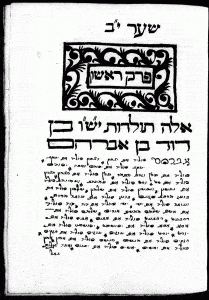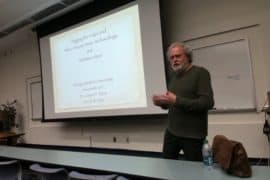
In this 2006 lecture I explore some of the rather remarkable textual readings of the 14th century polemical treatise Even Bochan [Isaiah 28:16] written by Shem-Tob ben-Isaac ben-Shaprut Ibn Shaprut, a Castilian Jewish physician, living later in Aragon. The 12th/ 13th book contains a Hebrew version of the complete text of Matthew.
This fascinating text, which I will refer to as Shem-Tov (ST), completed in 1380 CE was revised in 1385 & 1400. This is not to be confused with the Sebastian Münster (1537; dedicated to Henry VIII under title “The Torah of the Messiah” or Jean du Tillet (1555) versions of Hebrew Matthew. In 1690 Richard Simon mistakenly identified Shem-Tob’s Matthew with the versions of Münster and du Tillet.
George Howard’s 2nd edition, Hebrew Gospel of Matthew (Mercer University Press, 1995) is based on nine manuscripts of ST dating from 15th to 17th centuries; namely British Library Add no. 26964 for chapters 1:1-23:22; and JTS Ms. 2426 for 23:23-end.[1]Since Howard’s publication much more research has been done on this text by Nehemia Gordon and Keith Johnson, who have consulted all extant copies or manuscripts and have offered an ongoing … Continue reading
Howard wrote a comprehensive summary of his findings in Bible Review, available on-line from the Biblical Archaeology Society Library–to which I highly recommend my readers subscribe–the price is one of the greatest bargains out there for those interested in biblical studies. [2]Howard, George. “Was The Gospel of Matthew Originally Written In Hebrew?” Bible Review 2, no. 4 (1986): 15–17, 19–21, 23–25.Shem-Tov’s text is basically Biblical Hebrew (Vav Consecutive predominates) with a mixture of Mishnaic Hebrew and later rabbinic vocabulary and idiom. In addition the text reflects considerable revision to make it conform more closely to the standard Greek and Latin Gospel texts. The underlying text, Howard argued, reflects its original Hebrew composition, and it is the most unusual text of Matthew extant in that it contains a plethora of readings not found in any other codices of Matthew. It appears to have been preserved by the Jews, independent from the Christian community. Despite pushback by various critics I find Howard’s response in his 2nd edition to be quite convincing.
The text sometimes agrees in odd ways with Codex Sinaiticus. It contains some striking readings in common with the Gospel of John, but in disagreement with the other Gospels. It is very likely that the author of John polemized against the portrait of John the Baptizer that he found in as texts such as Shem Tov’s Hebrew Matthew. He might well have then known a Shem-Tov type Matthean text. ST also often agrees with the Lukan version of Q. ST also contains 22 agreements with the Gospel of Thomas.
It is most notable that Sinaiticus, Q, and Thomas were all lost in antiquity but found in modern times-making the parallels with ST all the more remarkable.
The Pseudo-Clementine writings (Recognitions and Homilies) when quoting or referring to Matthew occasionally agree with ST Hebrew Matthew against the canonical Greek versions.
Enjoy the lecture–and subscribe to my Youtube channel while you visit if you have not. The lecture notes I use are available on-line at my new web site: “The Jewish Roman World of Jesus.”
Also, if you like this post please sign up in the right sidebar (or at the bottom on mobile devices) for email notifications, and further on down my monthly newsletter. Emails are never shared are are kept totally confidential.









Comments are closed.